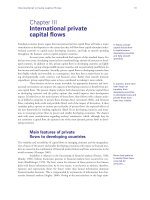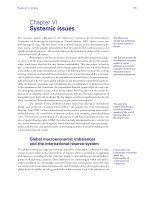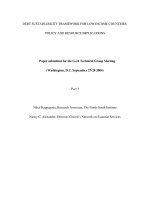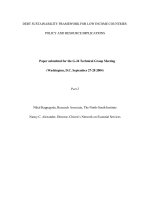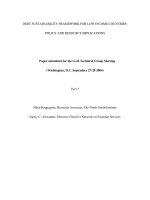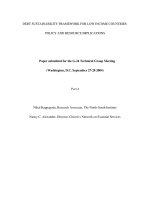Solar Resource
Bạn đang xem bản rút gọn của tài liệu. Xem và tải ngay bản đầy đủ của tài liệu tại đây (3.67 MB, 101 trang )
SOLAR RESOURCE
QUESTIONS
• What is solar resource? Why need to assess?
• Which forms of radiation are used in solar
projects?
• Solar constant? Extra terrestrial radiation?
• Solar radiation attenuants?
• Measurement (sensors?) quality?
• Ground measurements vs. others?
• Relative drawbacks?
• Need?
SOLAR RESOURCE
• Fuel for the power project for next 30
years
• Importance for
– Site selection
– Estimation of project parameters
• Electricity output estimation
• Cost
• Financial parameters
ASSESSMENT OF RESOURCE
• Ground measurements
– Limitations
• Forecast
– On site
– For life of project
– Limitations
ACCURACY
• Reduction in Uncertainty
• Project cost: Euro 2 – 4 million per MW
• Resource Assessment cost: Euro 50K (<
0.1%)
• Feasibility: Euro 50K (< 0.1%)
(mainly assessing the cost & performance)
• Bankability: Euro 50K (< 0.1%)
WHAT IS SOLAR RESOURCE?
•
•
•
•
•
•
•
Solar Spectrum
Universal Constant: 1,367 W / m2
Solar Cycle (11 years)
GHI: Global Horizontal Irradiation (PV projects)
DNI: Direct Normal Irradiation (CSP projects)
Diffuse (PV projects)
GHI = Diffuse + DNI * Cosine of Zenith angle
• ET radiation varies by 6.9% (1,321 – 1,412
W / m2) depending on the distance
• Variation in solar irradiation during the last
3 solar cycles < 0.1%
Top of Atmosphere radiation
Ozone.……….…....
Absorption ( 1%)
Air molecules..……
Aerosols…….………..…...……
Clouds………….………..
Water vapor…….……...………
Rayleigh scattering ( 15%)
Scattering and absorption (15% - 100%)
Reflection, scattering, absorption (max. 100%)
Absorption ( 15%)
Atmosphere attenuants affect considerably to the DNI on surface
WHY ASSESS SOLAR RESOURCE
• Map potential areas
– Policy
– Planning (resource, grid management)
•
•
•
•
•
Site selection
Electricity generation potential
Optimization and Design
Pre project feasibility
Financial Closure
HOW TO ASSESS SOLAR RESOURCE
• Ground measurements
– Solar meteorological station
• Interpolation
– Statistical methodology
• Satellite estimation
– Modeling algorithm
GROUND MEASUREMENTS
• Drawbacks
– Relative distances (~ 100 km)
– Deviations due to terrain
– On site measurements: not enough time
frame (11-year solar cycle)
– Instrumentation error (8%)
– Accuracy of data
– Incomplete data (erroneous data)
– Validated?
INTERPLOTATION
• Drawbacks
– Accuracy decreases
• over distance
• Terrain
– Statistical methodology
– Recent studies
• > 30% deviation from ground truth
SATELLITE
• From images of geostationary satellites
• Accuracy depends on
– Models
– Spatial resolution (3 km x 3 km)
– Temporal resolution (1/2 hour – 1 hour)
• Increasingly used for assessment
• Accuracy determined by comparison to
“ground truth”
Legend
o Measurements (GHI)
o Interpolated (GHI)
Reanalysis
AGENDA
•
•
•
•
Ground measuring stations
Quality Monitoring of Ground stations
Estimation from satellite images
Summary
GROUND MEASUREMENTS
JNNSM HIGHLIGHTS
• Solar Energy has a great potential as future
source of energy.
• India is a tropical country endowed with vast solar
energy potential(About 5,000 trillion kWh per year
energy is incident over India’s land area with most
parts receiving 4-7 kWh per sq. m per day).
• JNNSM was launched in 2009.
• Govt. of India in conjunction with States initiated
the JNNSM to provide the ecologically
sustainable growth.
JNNSM HIGHLIGHTS
• Major objective of JNNSM is to establish India
as a global leader in Solar Energy.
• It is proposed to generate 20,000 MW of Solar
power by 2022.
• Create favorable condition for solar
manufacturing capability.
• Promote off grid/decentralized application of
solar energy thereby empowering the people at
grass root level.
• Technological innovations (R&D) to drive down
costs towards grid parity.
JNNSM HIGHLIGHTS
• Detailed mapping of ground solar
insolation particularly in high potential solar
regions.
• Accurate and reliable Solar radiation data
is critical for all solar applications for
design and efficiency calculation.
• Establishment of solar radiation resource
assessment stations.(SRRA)
SOLAR IRRADIATION MAP
SOLAR RESOURCE ASSESSMENT
• First ‘Handbook of Solar Radiation Data for India’ was
published in 1981 containing data on Solar and Terrestrial
Radiation and Associated Meteorological Parameters for 18
stations.
• Revised Handbook on Solar Energy entitled, ‘Solar Radiant
Energy over India’ containing solar radiation and
Meteorological Data pertaining to 23 locations is available
along with CD. The data period covered is from 1986 to
2000.
• SEC initiated project on Solar Resource Assessment based
on satellite imagery with National Renewable Energy
Laboratory (NREL), USA.
SOLAR RESOURCE ASSESSMENT
• Solar maps (DNI & GHI) of North-Western India has
been made and are available in the MNRE website.
• These maps have been developed from hourly satellite
data spanning from Jan., 2002 to Dec., 2008 covering
the entire country at 10 Km x 10 Km resolution.
• Maps have been constructed based on completeness of
satellite data and performance compared with available
ground data with an accuracy of around 15%.
• Project revealed to identify the areas with higher solar
radiation to setup ground stations for accurate
measuring solar and meteorological parameters.
SOLAR RESOURCE ASSESSMENT
• Steps were taken to expand the network of Solar
Radiation Stations having high direct solar
radiation with a view to generate investment –
solar data to enable States and the developers
to take investment decisions.
• Task of setting up of solar radiation stations has
been assigned to Centre for Wind Energy
Technology (C-WET), Chennai being an
autonomous organization of the Ministry.
OBJECTIVES
•
•
•
•
Assess and quantify the ground data of solar
radiation
Establish
Solar
Radiation
Resource
Assessment(SRRA) stations covering potential
areas in the country.
Transmit data to Central Receiving Station
(CRS) established at C-WET, Chennai through
GPRS mode.
Data processing , modeling and making of
Solar Maps.

